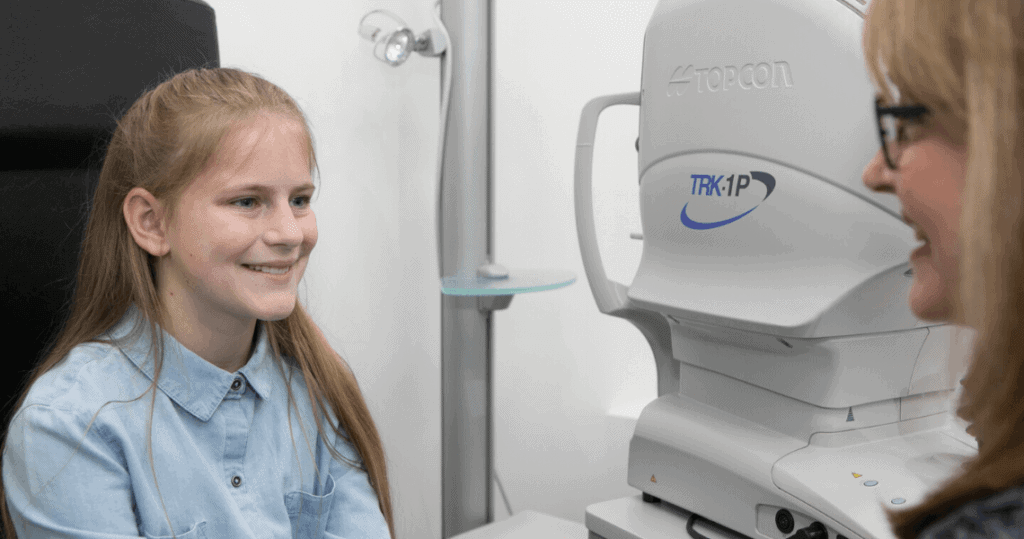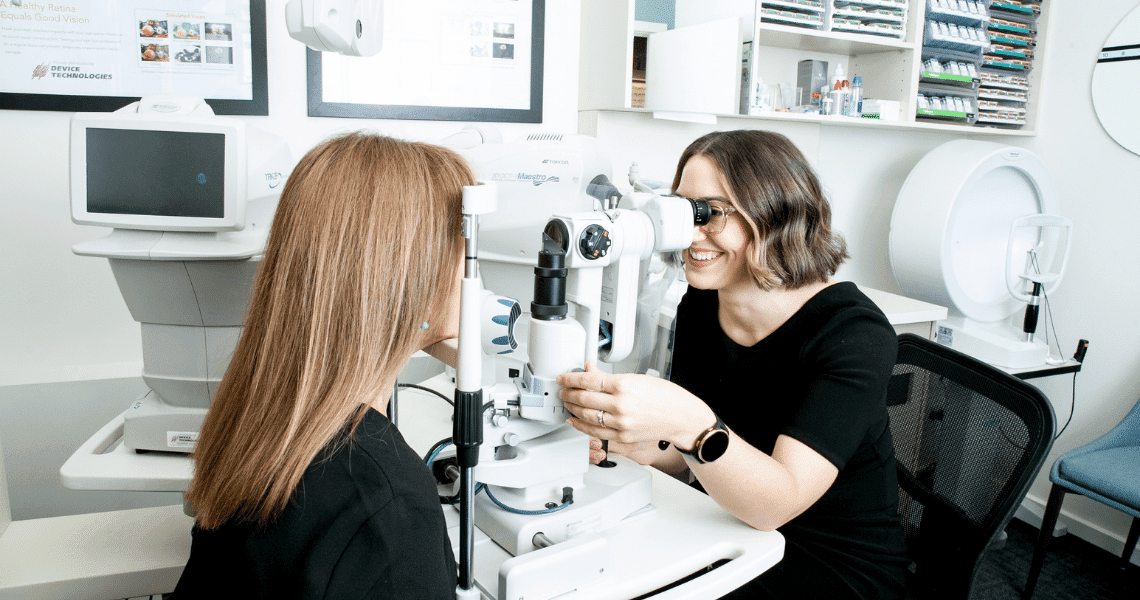Table of Contents

What is Myopia?
Myopia is blurry long-distance vision, often called ‘short-sightedness’ or ‘near-sightedness’. A person with myopia can typically see clearly up close – when reading a book or looking at a laptop screen – but words and objects look fuzzy on a whiteboard, on television, across the room, when looking outdoors or when driving. Development of myopia means the eye is longer than average length and images that pass through the pupil do not meet with the back of the eye, the retina, which in turn causes blurred far vision.
Why is myopia a concern?
The rate of myopia is growing across the world, increasing from 22% of the world’s population in 2000 to 33% in 2020 – half of the world’s population expected to be myopic by 2050.1 Most myopia is caused by the eye length growing too quickly in childhood. The eyes are meant to grow from birth until the early teens and then cease, but in myopia the eyes grow too much and/or continue growing into the teenage years. Once a child becomes myopic, their vision typically deteriorates every 6-12 months, requiring a stronger and stronger prescription. Most myopic children tend to stabilize by the late teens and early 20’s.2 Excessive eye growth raises concern because even small amounts of stretching can lead to increased likelihood of vision threatening eye diseases in later life, such as myopic macular degeneration, retinal detachment, and cataract.3,4
What are risk factors for myopia?
Myopia is genetically linked however exactly how is unknown. It is estimated that if one or both parents are myopic the risk is 60-90% higher in the child. Most of the current research is based on a population between ages 6 and 18 years of age.
There is continuing research and ever changing theories as to exactly why myopia may progress. There is some evidence that as well as genetics, some lifestyle factors contribute to the progression of myopia. The current research has found that it is not just the increase of near tasks or digital devices but that children are spending less time outdoors.
Why manage myopia in children?
Myopia progresses fastest in younger children, especially those under age 10.5 This means that the most important opportunity to slow eye growth is when children are younger. Myopia management aims to apply specific treatments to slow the excessive eye growth to a lesser rate. Experts agree that myopia management should be commenced for all children under age 12,6 and typically continue into the late teens.7 Current research has found that there is no level of myopia that can be considered “safe” in comparison to those who aren’t myopic.
The short-term benefit of slowing myopia progression is that a child’s prescription will change less quickly, giving them clearer vision for longer between eye examinations. The long-term benefit is reducing the lifetime risk of eye disease and vision impairment. This risk increases as myopia does3 with the good news being that reducing the final level of myopia by only 1 dioptre reduces the lifetime risk of myopic macular degeneration by 40% and the risk of vision impairment by 20%.8
Management options for slowing the progression of Myopia
Spectacles
Standard single-focus spectacles do not slow the worsening of childhood myopia but specific designs do. Myopia controlling spectacles can both correct the blurred vision of myopia and work to slow down myopia progression. They are safe to wear and adaptation is typically easy, with the only side effects being related to the limitations spectacles pose for sport and active lifestyles.
As with most emerging technologies there are always new products, the latest available is MiyoSmart, a lens that uses “D.I.M.S” technology. This has a moderate to strong reduction in myopia progression.
Older alternatives are MyoVision and MyoKids. These have been shown to have a weak to moderate reduction in myopia progression.
Contact Lenses
Standard single-focus contact lenses do not slow the worsening of childhood myopia but specific designs do. These specific designs can both correct the blurred vision of myopia and work to slow down myopia progression. The options include soft myopia controlling contact lenses and orthokeratology.
Risks and safety
Contact lens wear increases the risk of eye infection compared to wearing spectacles, with the risks being:
- 1 per 1,000 wearers per year for reusable soft contact lenses or overnight orthokeratology lenses9,10
- 1 per 5,000 wearers per year for daily disposable soft contact lenses9
With proper hygiene and maintenance procedures, this risk can be well managed – especially by avoiding any contact of water with contact lenses or accessories.11 Other side effects of contact lenses to control myopia can be temporary adaptation to the different experience of vision, which typically resolves in 1-2 weeks.
Benefits
There are many benefits to children wearing contact lenses:
- Wearing contact lenses improves children’s self confidence in school and sport, and their satisfaction with their vision – as much as it does for teens12
- Children aged 8-12 years appear to be safer contact lens wearers than teens and adults, with a lower risk of eye infection13
- Children only take 15 minutes more to learn how to handle contact lenses than teens14
Multifocal Soft Contact Lenses (MFSCLs)
Soft myopia controlling contact lenses are worn during waking hours. They may be daily disposable, or reusable for up to a month. They typically require more appointments for fitting than spectacles but less than orthokeratology. Adaptation to the lens-on-eye feeling typically occurs in a few days. There are benefits in safety with daily disposables being the safest modality, and the number of lenses retained meaning loss or breakage is less of a practical issue.
They have been shown to have a strong to moderate effectiveness in reducing the rate of myopia progression.
Orthokeratology (Ortho K)
Orthokeratology contact lenses are worn overnight and removed upon waking, such that no spectacles or contact lenses are required for clear vision during the day. They can require more appointments for fitting than other types of myopia control treatment. Adaptation to the lens-on-eye feeling can take 1-2 weeks but shouldn’t affect sleep.17 There are significant benefits for water sports and active lifestyles, and since the contact lenses are only worn at home there is low risk of them being lost or broken during wear.
These lenses work by gently reshaping the front structure of the eye, the cornea. Initial wear of these lenses may take some time to adjust but comfort and vision improves within a few days, worn consistently they can be an effective treatment for many years.
Studies have shown the effectiveness of Ortho K as strong when used in reducing the progression of myopia, making it one of the leading interventions, however, use of Ortho K should be maintained beyond age 14.18
Click here for more information about Ortho K.
Atropine eye drops
Atropine eye drops in strong concentrations (typically 0.5% to 1%) are used to temporarily dilate the pupil of the eye and stop the focussing muscles working in a variety of clinical applications. Atropine eye drops for myopia control, though, are a low-concentration (0.01% to 0.05%) with much fewer such side effects. Spectacles or contact lenses are still needed to correct the blurred vision from myopia, as atropine only acts to slow myopia progression.
Risks and safety
The risks and side effects of atropine are as follows:
- Potential side effects of increased sensitivity to light due to larger pupil size, which is typically resolved with light-sensitive glasses or sunglasses. One study found around a third of children requested these types of glasses, but this was the case even in the placebo (untreated) group.15
- Problems with close-up focussing, which is typically resolved with glasses providing a stronger power for reading. One study found this only occurred in 1-2% of children treated with low-concentration atropine.15
- Eye irritation or mild allergy, which can occur in 2-7%,15 although this can depend on the formulation of the atropine.
Atropine can be toxic and even fatal to small children if it is ingested in high quantities by mouth, but high quantity absorption via the eye is unlikely.16 Medication safety in the home is extremely important.
Benefits
Atropine eye drops are typically used at night time, before sleep, so are only utilized in the home environment. They are also ideal if the effective spectacle or contact lens options for myopia control are not suitable or not available for your child.
Despite strong research showing its strong to moderate efficacy in reducing myopia progression it is not yet approved by the Australian Therapeutic Goods Administration (TGA) for this purpose and hence the use of this scheduled medication is off label.
Higher clinically effective dosages, 0.05% and 0.025%, are not available commercially and a compounding pharmacy must make it, with a new bottle needed every month. Recently commercially available product has been released with a low dosage, 0.01%, which may be most effective when coupled with Orthokeratology.19
Environmental Factors
New research shows increased outdoor time is a protective factor for myopia progression.20
Alongside myopia management options it should be encouraged for children or teenagers with progressing myopia to spend more than 2 hours outside a day with appropriate UV protection such as hat, sunscreen and sunglasses eye protection.
Additionally a good habit to get into whilst indoors is to not hold any near work any closer than 30 cm and take frequent breaks while doing close work, every 30 minutes time should be taken to focus far away and allow the eyes to relax. Near tasks or near screen time outside of school should be limited to no more than 2 hours a day.
For more information on about Myopia in Children visit My Kids Vision, Child Myopia or MyMyopia.
References
- Holden et al 2016 https://pubmed.ncbi.nlm.nih.gov/26875007/
- COMET Group 2013 https://pubmed.ncbi.nlm.nih.gov/24159085/
- Flitcroft 2012 https://pubmed.ncbi.nlm.nih.gov/22772022/
- Tideman et al 2016 https://pubmed.ncbi.nlm.nih.gov/27768171/
- Chua et al 2016 https://pubmed.ncbi.nlm.nih.gov/27350183/
- Brennan et al 2020 https://pubmed.ncbi.nlm.nih.gov/33253901/
- Gifford et al 2019 https://pubmed.ncbi.nlm.nih.gov/30817832/
- Bullimore & Brennan 2019 https://pubmed.ncbi.nlm.nih.gov/31116165/
- Stapleton et al 2008 https://pubmed.ncbi.nlm.nih.gov/18538404/
- Bullimore et al 2013 https://pubmed.ncbi.nlm.nih.gov/23892491/
- Arshad et al 2019 https://pubmed.ncbi.nlm.nih.gov/30789440/
- Walline et al 2007a https://pubmed.ncbi.nlm.nih.gov/17993828/
- Bullimore 2017 https://pubmed.ncbi.nlm.nih.gov/28514244/
- Walline et al 2007b https://pubmed.ncbi.nlm.nih.gov/17873776/
- Yam et al 2019 https://pubmed.ncbi.nlm.nih.gov/30514630/
- North & Kelly 1987 https://pubmed.ncbi.nlm.nih.gov/2958765/
- Yang et al 2021 https://pubmed.ncbi.nlm.nih.gov/32674999/
- Cho P, Cheung SW. Discontinuation of orthokeratology on eyeball elongation (DOEE). Cont Lens Anterior Eye. 2017;40(2):82-87. doi:10.1016/j.clae.2016.12.002
- Atropine 0.01% combined with orthokeratology over two years – Myopia Profile
- Which Environmental Factors Potentially Reduce the Progression of Childhood Myopia? | BHVI
